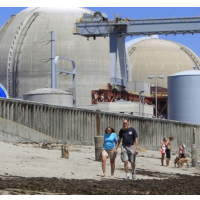Edison Has “Short-Sighted” Plan for Indefinitely Burying San Onofre Nuclear Waste
 San Onofre Nuclear Power Generating Station (photo: Orange County Register)
San Onofre Nuclear Power Generating Station (photo: Orange County Register)
Now that it’s been determined that ratepayers will probably pick up most of the cost of shutting down the prematurely degenerated San Onofre Nuclear Generating Station, plant operator Southern California Edison has settled on a questionable plan for storing spent nuclear fuel onsite for the foreseeable future.
Edison announced last week that it plans to move spent fuel rods from above-ground pools to steel fuel canisters, wrapped in concrete, topped with steel and more concrete, and buried beneath the bluffs between Los Angeles and San Diego. The plan is to bury the dangerously radioactive material for at least 20 years, until some place can be found to permanently move it.
Right now, there is no place. Democrats in the Senate and White House have blocked congressional Republicans from establishing Yucca Mountain, 100 miles from Las Vegas, as a national nuclear waste site. That could change in 2016.
There is not a long track record to judge the success of ongoing methods used to dispose of spent nuclear fuel. Europe reprocesses a lot of its fuel; the U.S. does not. That―and business and politics―have contributed to the use of different storage methods. While all the spent fuel piling up at U.S. nuclear plants that is dry casked uses thin-steel canister technology (up to ⅝”), Europeans favor a thick-walled (20”) container.
Donna Gilmore, founder of SanOnofreSafety.org, thinks Edison is making a mistake. She says the canisters sought by Edison for storing spent fuel cannot be repaired or inspected. There is no early-warning monitoring to detect things like stress corrosion cracks. Edison wants to spend $400 million on 100 canisters. Thick ones would cost more.
Speaking of the German alternative product, Gilmore told the Orange County Register, “Siempelkamp provides major nuclear services in the U.S., but the short-sighted U.S. utilities refuse to consider a better dry storage product that can be maintained and won’t crack. They are ignoring the fact that these will sit here for decades―maybe longer.”
Edison made the announcement as an advisory group it established, the Community Engagement Panel, released its report (pdf) expressing support for the plan. Chairman David G. Victor said the panel considered the thicker cask and whittled the options down. “We have casks that are widely used in the industry that deploy the latest technology and are licensed by the NRC. Those are the options.”
The report argued that Europeans used a thick-canister that can be accessed now because they regularly transport the material for repurposing. Americans keep it all onsite and don’t need that. It also warned about the uncertainties of cost and availability by using a product not already used here, which is not much of a vote for innovation.
A couple things that the report and its critics agreed on were that the fuel rods needed to be transferred out of the pools fast and that the fuel rods would be around for a lot longer than the 20-year disposal licensing period. “Indeed, the need for a long-term strategy emerged as one of the central themes of a survey” conducted in July, according to the report.
Good idea. Once they figure out how to bury the stuff they can start working on a plan to unbury the stuff and move it someplace that doesn’t have 8.4 million people living within 50 miles of unmonitored, unfixable, thin, decaying steel canisters holding nuclear fuel in earthquake-tsunami country.
Sounds like a plan.
–Ken Broder
To Learn More:
Watchdog: San Onofre Nuclear Rods to Stay in "Concrete Monolith" for Decades (by Teri Sforza, Orange County Register)
San Onofre Nuke Waste Goes Underground (by Morgan Lee, U-T San Diego)
Questions Raised about Storage of Spent Nuclear Fuel at San Onofre (by Alison St. John, KPBS)
Laguna Beach Residents Criticize San Onofre Cleanup (by Bryce Alderton, Los Angeles Times)
Customers Stuck with Most of the $4.8-Billion Bill for San Onofre (by Ken Broder, AllGov California)
Safety of Long-Term Storage in Casks: Issues for San Onofre (by David G. Victor) (pdf)
- Top Stories
- Controversies
- Where is the Money Going?
- California and the Nation
- Appointments and Resignations
- Unusual News
- Latest News
- California Forbids U.S. Immigration Agents from Pretending to be Police
- California Lawmakers Urged to Strip “Self-Dealing” Tax Board of Its Duties
- Big Oil’s Grip on California
- Santa Cruz Police See Homeland Security Betrayal in Use of Gang Roundup as Cover for Immigration Raid
- Oil Companies Face Deadline to Stop Polluting California Groundwater





